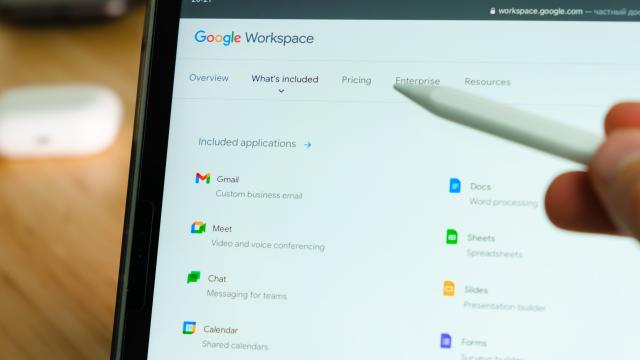Google will launch “Carbon Footprint for Google Workspace” in early 2023, according to a Tuesday blog post. The tool is an expansion on the compnay’s previous “Carbon Footprint for Google Cloud” calculator which debuted last year. The new widget allows companies using Google Workspace to quantify the greenhouse gas emissions linked to their usage of products like Gmail, Meet, and Drive. The calculator will account for both direct emissions from things like Google’s energy usage and less direct, “value chain” ones.
Every Google Doc, Sheet, Gmail, and Slide you type up has to be stored somewhere — a server that runs and recalls all those online files via a continuous supply of electricity. Soon Google will show companies reliant on its Workspace suite of products the climate impact of their portion of those servers.
That’s right, Google will tell its users how much harm they’re doing to the planet by using…Google websites. The tool was announced along with other a few other initiatives ahead of the Google Cloud Sustainability Summit. The company did not immediately respond to a request for comment.
The company also said it would introducing the option for Cloud users to source their server storage from “low-carbon locations.” Companies can opt to check a box that restricts their Cloud services to those generated in a select group of places more powered by renewables than elsewhere.
For companies hyper-focused on getting an accurate portrait of their total emissions, the knowledge may be useful. But in terms of making actual, meaningful change — it’s a little unclear what Google would want companies to do with their results. Should companies use fewer Google Docs? Less Google overall? Is Google saying that its own climate impact is actually everyone else’s climate impact? Maybe if big-ticket Google users simply thought more about the planetary effect of using Google, Google wouldn’t have to hurt the planet so much.
If the idea of a major corporation releasing an individual carbon emission estimator for its customers under the guise of sustainability sounds familiar, that’s because British Petroleum pioneered the idea nearly two decades ago to great effect. The original “carbon footprint calculator” was released by BP in 2004. After decades of climate change denial, fossil fuel companies decided to pivot to the notion of personal responsibility, deflecting the environmental focus away from themselves. The plan worked pretty well. We’re still constantly talking about individual carbon footprints — even though climate change is a problem that cannot be fixed at the individual level.
But I digress. Back to Google. On top of the the Workspace carbon calculator, the company also announced a new energy and emissions tracking tool, and new sustainability-focused partnerships.
To be fair, Google has also previously pledged to source all of its own energy from carbon-free sources by 2030 — which would a big environmental if done correctly. In the meantime, though, the company is falling short on real sustainability in other ways. Executives have publicly declared that Google is now carbon neutral based on offset purchases, which is a flimsy claim at best. And, despite all the sustainability lip service, Google continued to fund climate change denial as recently as 2019.
The grey area of Google’s environmental efforts highlights that, if we want companies to be better, they need to be held accountable to more than just shareholder profits.
